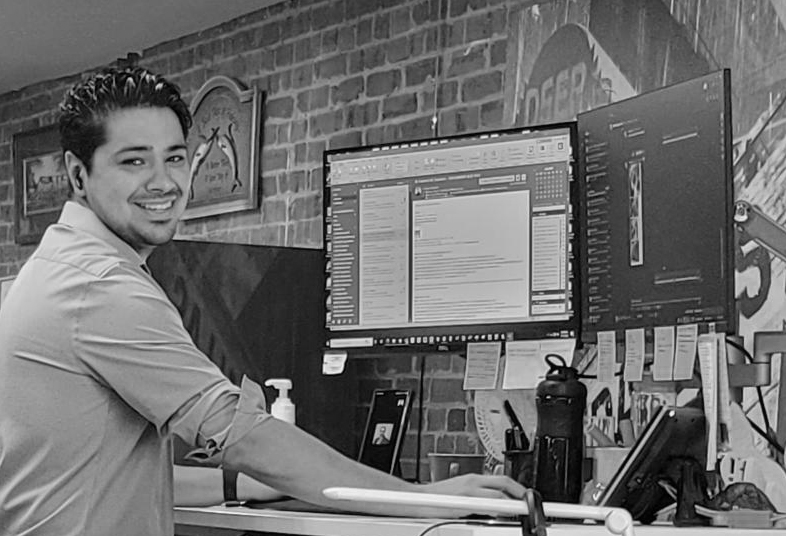10Qs: Getting to Know the People Behind the Projects…EJ
#10Qs #e4hfamily
Share

“I’ve been in and out of several different hospitals and care/treatment facilities. Although not having the direct patient experience, my experience as a family member drove me to wanting to improve the built conditions and how the spatial experience can be better tuned for all occupants.”
Emiliano (EJ) Márquez is a healthcare designer in the Dallas office. EJ is active in many E4H initiatives such as 4wrd and E4Hcares.
1. Where did you grow up?
I was born in Plano, TX and raised in Allen, TX. So I have been local all my life!
2. How did you get into design?
“Intro to Architectural Drafting and Design” class in high school my senior year, that I took on a whim since I needed to fulfill an elective. The teacher Mr. Mayberry, showed me the time, consideration, and effort required to complete certain tasks of taking a design into software. It was the only elective I had ever taken that I had real interest in that also really challenged me to not only keep up with, but have the desire to excel at. I never had a set plan of what I wanted to do post high school until that course.
3. Who influenced you?
My high school teacher for the aforementioned class, Mr. Mayberry. I never had any members of my immediate family with any architectural or engineering background, so I looked up to Mr. Mayberry as my mentor/role model in piquing my interest from my first steps into the design world.
4. Why healthcare architecture?
I initially wanted to do residential architecture as the scale of work and ability to manage the intricacies of design within, seemed really appealing to me based on all the high design houses I would enjoy seeing highlighted through several publications. During my final years at The University of Texas at San Antonio (UTSA) for grad school though, my mom had a cancer relapse (after having been considered cancer free for several years) that led to a brain tumor which ultimately led to her passing. Having said that, I’ve been in and out of several different hospitals and care/treatment facilities. Although not having the direct patient experience, my experience as a family member drove me to wanting to improve the built conditions and how the spatial experience can be better tuned for all occupants.
5. What inspires you?
Knowing that the work done is truly helping give a better experience for those that need it. One of the simplest books that illustrates this is “Design Like You Give a Damn: Architectural Responses To Humanitarian Crises“ by Cameron Sinclair. It highlights innovative design case studies that, when given limited resources, can still achieve good design while also addressing the critical need of the basic level of shelter for those who otherwise wouldn’t have it. Seeing high design is always interesting to me, but it’s the impact it has on end users that keeps me wanting to strive for experience creation.
6. What advice can you give young designers?
As designers, we’ve been given the training and skills to be able to illustrate a vision on paper that others can’t quite see. At times, this puts us in a very cumbersome, but very rewarding position. Cumbersome in that we have multiple factors we are always having to consider, while maintaining the balancing act of user feedback, maintaining budgets, utilizing creative materials, and weaving through the restrictiveness of code compliance/life safety, all while we strive for high design and long-lasting spatial experience. Rewarding in the sense that all the effort put in, gets reflected in the end product. Additionally, when you get end user follow up with positive feedback about what worked, what doesn’t quite work, and what to improve on, as you continue building that relationship of reliability with your clientele. You don’t have to do everything on your own. Nothing is more valuable to your growth as an individual as well as a designer than using all the resources you have around you, especially your colleagues!
7. Most memorable projects?
Some of my most memorable projects here at E4H were definitely with Cook Children’s clinics. They had fun standards and allowed us to have some creative design liberties. The end users with the system were always incredibly friendly and excited about the projects all while being curious to the design process and not just the end results.
8. What is your favorite part of the design process?
My favorite part would have to be working through programmatic ideas and bringing them into a schematic design level plan for client/end user review. The moment you turn bubbled squares and colored blobs into populated rooms and walk the client through the plans, acting as the translator between 2D lines (that they may not always understand) and bringing their vision/thoughts to life as part of the discussion, has always been part of the design process I’ve had the most fun.
9. Where do you see healthcare design in 5 years?
I honestly see healthcare progressing towards more pop-up/mobile clinics that could better serve the community. With telemed rooms becoming more integral in projects due to the efficiency and convenience of travel time saved, I imagine that pop-up/mobile clinics would have more impact and presence to underserved communities. More than a centralized location such as a hospital that might already present complications of travel access, costs associated, and disconnect with the community.
10. How do you unplug?
I usually go for a run, play some soccer, and a bit of gaming. I’m a huge fan of watching movies, no matter how bad or good. Sometimes you can find some hidden gems in the endless scrolling you can do on any of the streaming apps!